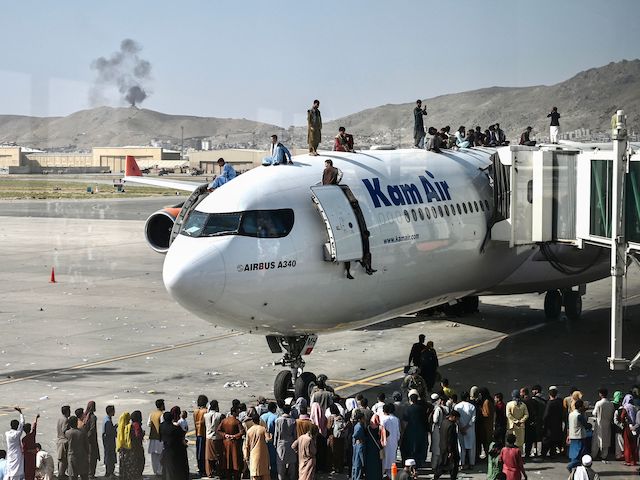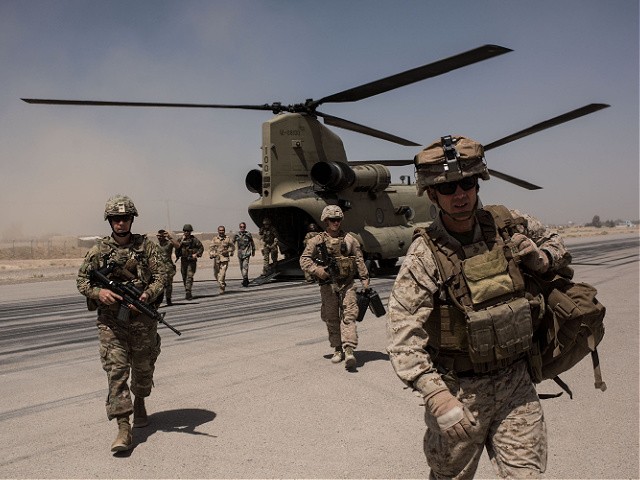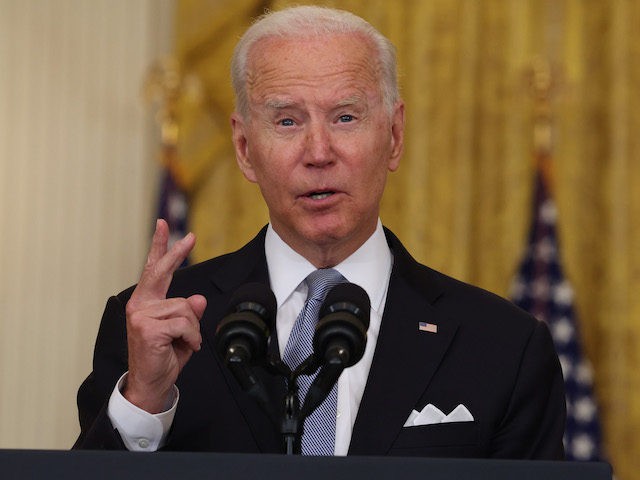President Joe Biden used an address to the American public on Monday afternoon to defend his alleged decision to withdraw militarily from Afghanistan, just hours after approving a 6,000-troop deployment to the country and nearly four months after the date U.S. troops would have withdrawn if he had not changed the deadline.
Biden took a brief respite from his vacation at Camp David on Monday after Taliban jihadists surrounded Kabul, the capital of Afghanistan, on Sunday, prompting now-former Afghan President Ashraf Ghani to flee the country. Ghani’s whereabouts remain unknown at press time, though reports indicated he fled in a helicopter with more cash than what could fit in the aircraft. The swift collapse of the U.S.-backed Kabul government officially concluded with a Taliban press conference held at the Afghan presidential palace on Sunday evening in which the jihadists urged Afghans to accept their radical Islamist rule and not flee the country.
While much of Kabul appeared calm on Monday, dramatic scenes unfolded at Kabul’s international airport following the cancelation of all commercial flights. Desperate Afghans attempted to board U.S. military planes to flee the country, resulting in some reports of individuals grabbing the outside of airplanes as they took off and plunging to their deaths. Mobs flooded the tarmacs seeking an escape from the country. The White House’s full plan for evacuating Americans and Afghans in mortal danger due to their ties to the U.S. government remain unclear at press time.

Afghan people climb atop a plane as they wait at the Kabul airport in Kabul on August 16, 2021, after a stunningly swift end to Afghanistan’s 20-year war, as thousands of people mobbed the city’s airport trying to flee the group’s feared hardline brand of Islamist rule. (Wakil Khosar/AFP via Getty Images)
Biden largely did not address the chaos at the Kabul airport, only vaguely lamenting the “scenes” out of the capital. He instead forcefully made the argument that the United States should not have a military presence in Afghanistan – a presence Biden extended in April.
Under former President Donald Trump, the U.S. government had signed an agreement with Taliban forces that would have seen American forces completely withdraw from the country by May 1, 2021, in exchange for Taliban jihadists cutting ties with international terrorist groups like al-Qaeda and ceasing attacks on Americans. Biden chose to break that agreement, extending the Afghan War. Biden initially set the full withdrawal date to the 20th anniversary of the September 11, 2001, terrorist attacks, but then revised the date to August 31.
The Taliban announced following Biden’s extension of the war that it did not consider itself bound by the provisions of the agreement anymore since Biden had broken it. It launched 22,000 attacks between April when Biden broke the deal, and July, according to the now-defunct Afghan government.
At the time of Trump’s agreement, 2,500 troops remained in Afghanistan. Biden approved the deployment of 6,000 troops to Afghanistan this weekend; he did not guarantee they would be out by August 31.
“Our mission in Afghanistan was never supposed to be nation-building,” Biden told the public. “As president, I’m adamant we focus on the threats we face today, in 2021, not yesterday’s threats.”

U.S. service members walk off a helicopter on the runway at Camp Bost on September 11, 2017, in Helmand Province, Afghanistan. (Andrew Renneisen/Getty Images)
“American troops cannot and should not be fighting in a war and dying in a war that Afghan forces are not willing to fight themselves,” Biden argued, adding that the flight of top Afghan officials, including the president, from the country “reinforce that ending U.S. military involvement in Afghanistan now is the right decision.”
Biden decried “endless military deployments” and asked the public, “How many more generations of America’s daughters and sons would you have me send to fight Afghanistan’s civil war when Afghan troops will not?” He continued, “How many more lives, American lives, is it worth? How many endless rows of headstones at Arlington National Cemetery? I am clear on my answer.”
“I stand squarely behind my decision,” Biden said, apparently referring to a decision to withdraw, not to remain in Afghanistan. “After 20 years, I’ve learned the hard way that there was never a good time to withdraw U.S. forces. That’s why we’re still there.”
In the same speech, he identified exactly one time that was particularly worse than all others for the withdrawal: May 1. He claimed that “no ceasefire” would have occurred after that date if he had withdrawn all forces as the Trump agreement required, thus putting the American forces, which presumably would no longer be there, in danger.
“U.S. forces had already drawn down during the Trump administration from roughly 15,500 American forces to 2,500,” Biden admitted, without noting that Biden himself was vice president prior to that drawdown.
“The choice I had to make as president was either follow through on that agreement or be prepared to go back and fight the Taliban,” Biden argued. He did not elaborate on why he believed U.S. troops would have to reenter the country to fight the Taliban after the withdrawal, a confusing argument given his repeated assertions that Americans should not fight wars on behalf of the Afghan people.
The speech concluded with assurances that Biden would aid the departure of “vulnerable Afghans” from the country.

COMMENTS
Please let us know if you're having issues with commenting.